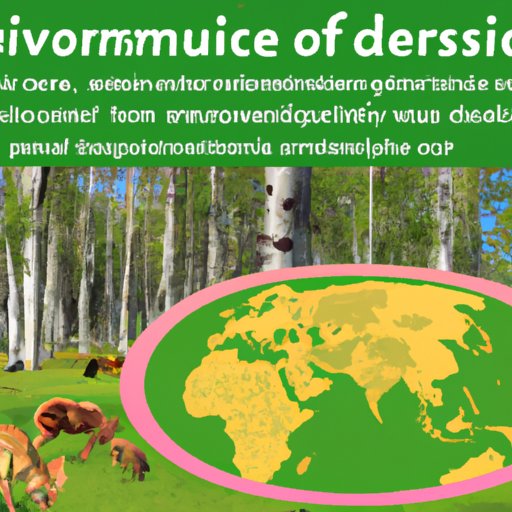Introduction:
An ecosystem is defined as a community of living organisms interacting with one another and their environment. The world’s largest ecosystem is the Amazon Rainforest, located in South America. Spanning across nine countries and covering an area of 5.5 million square kilometers, it is the largest rainforest in the world, and is home to a diverse range of flora and fauna. This article will explore the physical features, biodiversity, and economic benefits of the Amazon Rainforest, as well as examine the conservation efforts for this unique ecosystem.
Describing the Physical Features of the World’s Largest Ecosystem
The Amazon Rainforest is located in South America, spanning across nine countries. These countries include Brazil, Peru, Colombia, Venezuela, Ecuador, Bolivia, Guyana, Suriname, and French Guiana. The majority of the forest lies within Brazil, covering approximately 60% of the country’s land area. The Amazon River runs through the heart of the rainforest, with its tributaries extending outwards to cover an area of 5.5 million square kilometers.
The climate of the Amazon Rainforest is mostly tropical, with high temperatures and humidity throughout the year. Average temperatures range from 20°C to 25°C. The region experiences two distinct seasons: a wet season between December and May, and a dry season between June and November. The landscape of the Amazon Rainforest is characterized by low-lying plains, hills, and mountains. The terrain is mostly flat, with some areas reaching elevations of up to 3,000 meters.
Exploring the Biodiversity of the World’s Largest Ecosystem
The Amazon Rainforest is home to a rich diversity of plants and animals. There are an estimated 390 billion individual trees in the rainforest, making up around 16,000 species of trees. The rainforest is also home to over 2.5 million insect species, as well as thousands of species of birds, mammals, reptiles, and amphibians. Some of the most iconic species found in the Amazon Rainforest include jaguars, macaws, sloths, and river dolphins.
The Amazon Rainforest is also home to many unique plants and animals that can only be found in this region. These include the giant anteater, the black-faced spider monkey, and the Victoria amazonica water lily. In addition, there are several endangered species that call the Amazon home, such as the yellow-footed tortoise and the white-bellied spider monkey.
Investigating the Human Impact on the World’s Largest Ecosystem
The human impact on the Amazon Rainforest has been significant. Pollution from industry, agriculture, and mining has caused widespread damage to the ecosystem. The over-exploitation of resources has resulted in deforestation and habitat destruction, leading to the loss of numerous species. In addition, hunting and fishing activities have had a negative impact on wildlife populations.
Examining the Conservation Efforts for the World’s Largest Ecosystem
In recent years, conservation efforts have been implemented in order to protect the Amazon Rainforest. Governments have created protected areas and national parks in order to preserve the biological diversity of the region. International organizations such as the World Wildlife Fund have launched campaigns to raise awareness about the importance of preserving the Amazon. In addition, indigenous communities have come together to form their own conservation initiatives.
Highlighting the Unique Flora and Fauna of the World’s Largest Ecosystem
The unique flora and fauna of the Amazon Rainforest are of great economic value. Many medicinal plants and herbs are found in the rainforest, and are used in traditional medicines. The timber industry relies heavily on the rainforest for timber and other wood products. In addition, the wildlife of the Amazon is a major tourist attraction, drawing visitors from all over the world.
Investigating the Economic Benefits of the World’s Largest Ecosystem
The economic benefits of the Amazon Rainforest extend beyond its unique flora and fauna. The Amazon is home to a vast array of natural resources, including oil, gas, minerals, and water. These resources provide a valuable source of income for local communities and businesses. In addition, the rainforest plays an important role in regulating global climate patterns, and helps to maintain a healthy global environment.
Comparing the World’s Largest Ecosystem to Other Ecosystems
When compared to other ecosystems, the Amazon Rainforest stands out as the largest and most biodiverse. The Amazon is home to more species than any other ecosystem, and its size makes it particularly vulnerable to human interference. Conservation efforts for the Amazon are also unique, as governments, international organizations, and local communities have all come together to protect this vital ecosystem.
Conclusion
The Amazon Rainforest is the world’s largest ecosystem, spanning across nine countries in South America. It is home to a vast array of flora and fauna, as well as many unique species. The human impact on the rainforest has been significant, with pollution, deforestation, and over-exploitation of resources all having a negative effect. However, conservation efforts have been implemented in order to protect this vital ecosystem. The Amazon Rainforest provides numerous economic benefits, and its preservation is essential for maintaining a healthy global environment.


